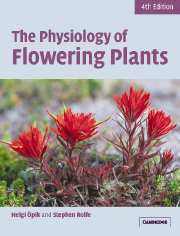Book contents
- Frontmatter
- Contents
- Preface
- Chapter 1 Introduction
- Part I Nutrition and transport
- Part II Growth and development
- Chapter 6 Growth as a quantitative process
- Chapter 7 Plant growth hormones
- Chapter 8 Cell growth and differentiation
- Chapter 9 Vegetative development
- Chapter 10 Photomorphogenesis
- Chapter 11 Reproductive development
- Chapter 12 Growth movements
- Chapter 13 Resistance to stress
- Appendix
- Index
- References
Chapter 11 - Reproductive development
Published online by Cambridge University Press: 05 June 2012
- Frontmatter
- Contents
- Preface
- Chapter 1 Introduction
- Part I Nutrition and transport
- Part II Growth and development
- Chapter 6 Growth as a quantitative process
- Chapter 7 Plant growth hormones
- Chapter 8 Cell growth and differentiation
- Chapter 9 Vegetative development
- Chapter 10 Photomorphogenesis
- Chapter 11 Reproductive development
- Chapter 12 Growth movements
- Chapter 13 Resistance to stress
- Appendix
- Index
- References
Summary
Introduction
Reproductive development of flowering plants has been studied for many hundreds, if not thousands, of years. This is not surprising, given the importance of flowering, fruiting and seed setting in agriculture. Society also has a fascination with producing ever more diverse flowers for horticultural purposes. The rose is the oldest known domesticated flower and its popularity endures today; over 103 million roses are sent for Valentine's day in the USA alone, with the global trade in all cut flowers exceeding $4 billion annually. Moreover, since cut flowers are desired at all seasons, control of the time of flowering has great commercial value. Hence a study of the reproductive processes of flowering plants is of great economic importance as well as enabling us to understand the functioning of plants in their natural ecosystems.
Juvenility and ‘ripeness to flower’
Vegetative growth eventually leads to a transition to reproductive development. However, plants will not flower, nor respond to environmental stimuli which ensure subsequent flowering, until they have completed a certain period of vegetative growth and reached ‘ripeness to flower’. A plant can therefore be considered to pass through three growth phases:
juvenile – in which it will not flower
mature – in which appropriate environmental stimuli will evoke flowering
reproductive – in which flowering actually takes place
- Type
- Chapter
- Information
- The Physiology of Flowering Plants , pp. 270 - 317Publisher: Cambridge University PressPrint publication year: 2005
References
- 1
- Cited by



